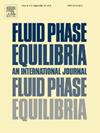Effect of cross-sectional geometry, area, and solid-fluid interaction strength on liquid droplets and bridges inside nanopores
Abstract
We use molecular dynamics simulations to study liquid droplets and bridges inside crystalline pores having triangular, square, hexagonal, and circular cross-sections of varying dimensions. The role of wettability is also investigated by varying solid-fluid interaction strengths. We analyze the stability of liquid droplet or bridge, the density distribution within a droplet or bridge, and the propensity of liquid to occupy corners of polygonal cross-sections of pores. The solid-fluid interfacial free energies calculated from Monte Carlo simulations and a thermodynamic model are used to estimate the free energy change of liquid occupying the corners of a pore. Liquid droplets and liquid bridges are observed for weakly and strongly attractive nanopores, respectively. Both droplets and bridges are unstable inside nanopores having the largest cross-sectional dimension smaller than 10 molecular diameters. Both the liquid configurations are more unstable inside nanopores having hexagonal cross-sections. The propensity of liquid to occupy the corners of a polygonal cross-section of a nanopore decreases with decrease in the number of sides of the polygon.

 求助内容:
求助内容: 应助结果提醒方式:
应助结果提醒方式:


